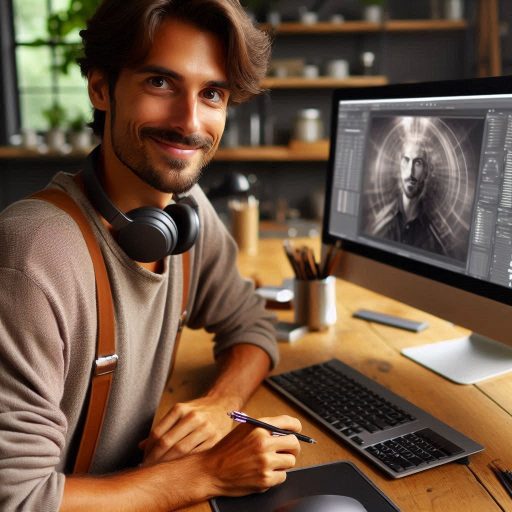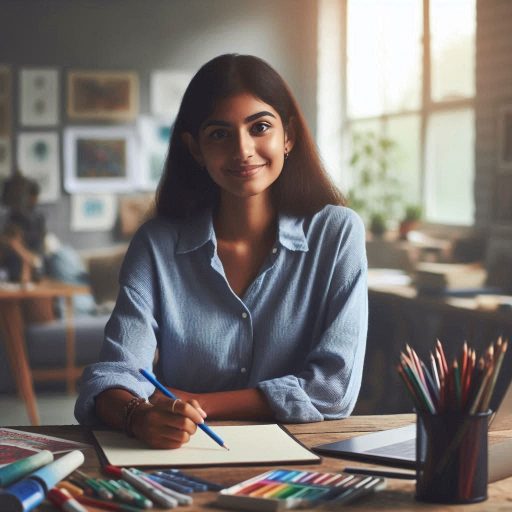Introduction
Digital art represents a fusion of creativity and technology, shaping the art world today.
This innovative medium uses digital tools to create visually compelling pieces.
Digital art includes everything from illustrations to 3D models, and it thrives in various industries, including gaming, film, and advertising.
Its significance lies in its accessibility and versatility, allowing artists to explore new forms and techniques.
In today‘s world, digital art is not just a trend but a transformative force.
It democratizes art creation, enabling anyone with a computer or tablet to create professional-quality work.
The ease of sharing digital creations online further amplifies its impact, connecting artists with global audiences.
This blog post delves into the essential tools and techniques that define digital art.
First, we’ll explore software options, which range from user-friendly applications to complex programs tailored for professionals.
These tools are crucial for executing various styles and techniques effectively.
Next, we’ll cover hardware essentials, including graphic tablets and styluses that enhance precision and creativity.
Understanding how to use these devices can significantly improve the quality of your work.
Finally, we‘ll discuss techniques such as layering, blending, and texturing.
These methods allow artists to add depth and detail to their digital pieces.
Mastering these techniques is key to producing stunning digital art that stands out in the crowded online space.
By the end of this post, you’ll have a solid understanding of the tools and techniques used in digital art.
Whether you‘re a beginner or looking to refine your skills, this guide aims to provide valuable insights to elevate your digital art practice.
Understanding Digital Art
Digital art and its evolution
Digital art merges creativity with technology, creating unique visual experiences.
Defined as art produced or manipulated with digital tools, it has evolved rapidly.
Originally, digital art began with simple graphics created on early computers.
Transform Your Career Today
Unlock a personalized career strategy that drives real results. Get tailored advice and a roadmap designed just for you.
Start NowOver time, advancements in software and hardware have expanded its possibilities.
Today, digital art encompasses everything from digital paintings to complex 3D models.
Importance of digital art in various industries such as advertising, entertainment, and design
The importance of digital art spans multiple industries.
In advertising, it captivates audiences with eye-catching visuals and innovative designs.
Companies use digital art to create memorable branding and compelling marketing materials.
Digital art’s precision and versatility enhance visual communication, making ads more effective.
In the entertainment industry, digital art plays a crucial role.
It fuels the creation of stunning visual effects, animation, and game design.
Movies and video games rely on digital art to build immersive worlds and dynamic characters.
This art form allows for endless creativity and complex visual storytelling.
The design sector also benefits significantly from digital art.
Graphic designers use digital tools to craft logos, websites, and packaging.
Digital art facilitates precise adjustments and quick iterations, streamlining the design process.
It also enables designers to experiment with styles and techniques without traditional constraints.
Overall, digital art has transformed how we create and experience visual content.
Its influence stretches across advertising, entertainment, and design, making it an essential tool in modern creativity.
Understanding its evolution and applications highlights the significant impact of digital art on various industries.
Read: Resources for Aspiring Costume Designers
Essential Tools for Creating Digital Art
Creating digital art requires a blend of hardware and software to bring your vision to life.
Here‘s a breakdown of the essential tools you need.
Transform Your Career Today
Unlock a personalized career strategy that drives real results. Get tailored advice and a roadmap designed just for you.
Start NowOverview of Hardware Like Graphic Tablets and Styluses
Graphic tablets are crucial for digital artists.
They provide a natural drawing experience similar to pen and paper.
Tablets such as Wacom, Huion, and XP-Pen offer different sizes and sensitivity levels.
Look for features like pressure sensitivity and tilt recognition to enhance your control.
Styluses, which come bundled with tablets or sold separately, should have a comfortable grip and responsive tip.
Brands like Wacom‘s Pro Pen and Apple Pencil are popular for their precision and ease of use.
Together, these tools create a seamless drawing experience, allowing for more detailed and nuanced artwork.
Overview of Software Programs Like Adobe Photoshop, Illustrator, and Procreate
Software programs are just as important as hardware.
Adobe Photoshop is a versatile tool for photo editing and digital painting.
Its layers, brushes, and filters provide extensive creative options.
Illustrator, also from Adobe, excels in vector graphics, making it ideal for creating logos and detailed illustrations that can scale without losing quality.
For a more intuitive and streamlined approach, Procreate offers a user-friendly interface on iPads.
It‘s known for its responsive brush system and robust feature set.
Choosing the right software depends on your artistic needs and workflow preferences.
In summary, combining high-quality hardware with powerful software creates a robust toolkit for digital art.
Invest in reliable graphic tablets and styluses for precise control, and select software that aligns with your artistic goals.
With these tools, your digital art can achieve both technical excellence and creative expression.
Read: Resources for Aspiring Costume Designers
Techniques for Creating Digital Art
Creating digital art involves mastering various tools and techniques.
Two crucial aspects are understanding different brush and pen tools and employing layering techniques.
Transform Your Career Today
Unlock a personalized career strategy that drives real results. Get tailored advice and a roadmap designed just for you.
Start NowDifferent Brush and Pen Tools Available in Digital Art Software
Digital art software offers a wide range of brush and pen tools, each with unique features.
Basic brushes come in various shapes and sizes, ideal for different strokes and textures.
For example, round brushes are versatile and can produce smooth lines or detailed textures.
Flat brushes are perfect for creating broad, even strokes or sharp edges.
Pen tools, often used for precise lines and curves, vary in pressure sensitivity and opacity settings.
Customizable brushes allow artists to create unique textures and effects by adjusting size, hardness, and spacing.
Specialized brushes, like watercolor or splatter brushes, simulate traditional mediums, adding authenticity to digital artwork.
Layering Techniques to Create Depth and Texture in Digital Art
Layering is essential for adding depth and texture to digital art.
By working on multiple layers, artists can separate different elements of their artwork.
This method allows for easier adjustments without affecting the entire piece.
Start with a background layer, then add subsequent layers for different elements, such as characters, objects, and details.
Utilize layer blending modes to create various effects, such as overlays or shadows, enhancing the depth of the image.
For texture, artists can use texture brushes or import texture images onto separate layers.
Adjusting the opacity and blending modes of these layers helps integrate textures seamlessly into the artwork.
In short, mastering different brush and pen tools and employing effective layering techniques are key to creating compelling digital art.
Experimenting with these tools and techniques can enhance your digital artwork’s detail, depth, and overall quality.
Read: How to Price Your Costume Design Work
Tips for Beginners in Digital Art
Understand the Basics‘
Before diving into creating digital art, it is essential to understand the basic principles of art.
This includes learning about color theory, composition, perspective, and lighting.
Having a solid foundation in these principles will help you create more visually appealing and professional-looking digital art.
Transform Your Career Today
Unlock a personalized career strategy that drives real results. Get tailored advice and a roadmap designed just for you.
Start NowExperiment with Different Tools‘
There are a variety of digital art tools available, such as graphic tablets, drawing software, and stylus pens.
Experiment with different tools to find what works best for you.
Some artists prefer using a graphic tablet for drawing, while others may prefer using a stylus pen on a touchscreen device.
Try out different tools to see which ones suit your style and workflow.
Study Other Artists’ Work‘
One of the best ways to improve your digital art skills is by studying the work of other artists.
Analyze their techniques, styles, and approaches to creating art.
This can help you gain inspiration and develop your own unique style.
Look for online resources, art books, and exhibitions to explore a wide range of art styles and techniques.
Practice Consistently‘
Like any skill, digital art requires consistent practice to improve.
Set aside dedicated time each day or week to work on your art.
Practice drawing different subjects, experimenting with colors, and trying out new techniques.
The more you practice, the more you will improve your skills and develop your artistic style.
Seek Feedback and Critique‘
Don’t be afraid to seek feedback and critique from other artists or art communities.
Sharing your work with others can help you gain valuable insights and perspectives on your art.
Constructive criticism can point out areas for improvement and help you grow as an artist.
Join online art forums, social media groups, or art classes to connect with other artists and receive feedback on your work.
Don’t Be Afraid to Make Mistakes‘
Art is a process of experimentation and learning.
Don’t be afraid to make mistakes or try new things in your digital art.
Mistakes are a natural part of the creative process and can lead to new discoveries and breakthroughs.
Embrace the imperfections in your art and use them as opportunities for growth and improvement.
Transform Your Career Today
Unlock a personalized career strategy that drives real results. Get tailored advice and a roadmap designed just for you.
Start NowStay Inspired and Motivated‘
Creating digital art can be a rewarding but challenging journey.
It’s important to stay inspired and motivated throughout the process.
Surround yourself with inspiring artwork, follow other artists on social media, and engage in creative activities outside of digital art.
Find sources of inspiration that resonate with you and keep you motivated to continue creating art.
Have Fun and Enjoy the Process‘
Above all, remember to have fun and enjoy the process of creating digital art.
Art is a form of self-expression and creativity, so don’t put too much pressure on yourself to be perfect. Experiment, explore, and have fun with your art.
Let your imagination run wild and see where it takes you.
Enjoy the journey of creating digital art and celebrate your progress along the way.
Read: From Concept to Creation: Costume Design

Advanced Techniques for Experienced Artists
Creating digital art offers endless possibilities.
For experienced artists, mastering advanced techniques can elevate their work to new levels.
This section explores two key methods: experimenting with blending modes and filters, and using custom brushes and effects.
Experiment with Different Blending Modes and Filters
Blending modes can dramatically alter how colors and textures interact.
Each mode affects the layer’s transparency and color blending.
Start by applying different blending modes to see how they affect your artwork.
Experiment with modes like Overlay, Multiply, and Screen to achieve various effects.
Filters can also transform your digital art.
They can sharpen details, add textures, or create artistic effects.
Apply filters cautiously to enhance without overwhelming your composition.
Adjust filter settings to fine-tune the results and ensure they complement your overall vision.
Transform Your Career Today
Unlock a personalized career strategy that drives real results. Get tailored advice and a roadmap designed just for you.
Start NowExplore the Use of Custom Brushes and Effects
Custom brushes allow you to add unique textures and details to your digital art.
You can create brushes that mimic traditional media or invent entirely new textures.
Experiment with brush settings like size, opacity, and flow to achieve desired effects.
Use custom brushes to add depth and variety to your artwork.
Effects can also bring a unique flair to your digital pieces.
Incorporate effects like glows, shadows, or distortions to add dimension and emphasis.
Experiment with different effects to see how they alter the mood and impact of your art.
Incorporating these advanced techniques requires practice and experimentation.
Push the boundaries of your creativity by integrating blending modes, filters, custom brushes, and effects into your workflow.
The result will be digital art that stands out with a personal and professional touch.
Embrace these methods to refine your skills and produce visually compelling and unique artworks.
Incorporating Traditional Art Elements into Digital Art
Exploring the Fusion of Traditional and Digital Art
Traditional art forms have a rich history and a unique charm that many artists find appealing.
However, with the advancement of technology, the digital art world has opened up new possibilities for creative expression.
As a result, many artists are now exploring ways to incorporate traditional art elements into their digital work.
Here are some techniques for seamlessly blending traditional and digital art:
Scanned Illustrations or Paintings‘
One way to bring traditional art elements into your digital work is by scanning illustrations or paintings created using traditional mediums, such as watercolors or acrylics.
By digitizing these pieces, you can use them as a base for further digital manipulation.
Once you have scanned your traditional art, you can import it into digital art software, such as Adobe Photoshop or Procreate, to further enhance and modify the piece.
This process allows you to combine the tactile quality of traditional art with the flexibility and versatility of digital tools.
Creating Hybrid Art Pieces‘
Another way to incorporate traditional art elements into your digital work is by creating hybrid art pieces that blend both mediums seamlessly.
Transform Your Career Today
Unlock a personalized career strategy that drives real results. Get tailored advice and a roadmap designed just for you.
Start NowThis approach involves combining digital elements, such as vector graphics or digital painting, with traditional media, such as collage or mixed media.
By merging these different mediums, you can create unique and visually compelling artworks that showcase the best of both worlds.
Experiment with different combinations of traditional and digital elements to discover new techniques and styles that speak to your artistic vision.
Benefits of Combining Traditional and Digital Art
There are several benefits to incorporating traditional art elements into your digital work:
Adds Depth and Texture‘
Traditional art mediums often provide a sense of depth and texture that can be challenging to replicate digitally.
By blending traditional elements with digital techniques, you can create artworks that have a tactile quality and visual interest.
Enhances Creativity and Experimentation‘
Experimenting with the fusion of traditional and digital art allows you to push the boundaries of your creativity and explore new artistic possibilities.
This blend of mediums can inspire fresh ideas and innovative techniques that can enrich your artistic practice.
Connects Past and Present Art Practices‘
By combining traditional and digital art elements, you can create a bridge between past and present art practices.
This fusion honors the rich history of traditional art while embracing the advancement of digital technology, resulting in artworks that are both timeless and contemporary.
Integrating traditional art elements into digital art opens up a world of creative opportunities and allows artists to explore new techniques and styles.
By experimenting with the fusion of traditional and digital mediums, artists can create unique and visually compelling artworks that showcase the best of both worlds.
Explore Further: Best Software for Motion Graphics Design
Collaboration and Sharing in Digital Art
Collaboration and sharing are key components of the digital art community.
By connecting with other artists online, you can learn new techniques, gain inspiration, and even collaborate on projects together.
Use Online Platforms and Communities to Connect with Other Digital Artists
- Join social media platforms like Instagram, Twitter, and Facebook to showcase your work and connect with other artists.
- Explore online forums and communities such as Reddit, DeviantArt, and ArtStation to engage with a larger audience.
- Attend virtual events and webinars hosted by digital art organizations to network with professionals in the industry.
By actively participating in these online platforms, you can build a strong network of like-minded individuals who can support and inspire you in your creative journey.
Participate in Challenges and Contests to Showcase Your Work and Improve Skills
- Join art challenges like Inktober, Drawlloween, or daily drawing prompts to push yourself outside your comfort zone.
- Enter digital art contests hosted by companies, art websites, or magazines to gain exposure and recognition for your work.
- Collaborate with other artists on themed projects or challenges to explore new ideas and techniques.
By participating in challenges and contests, you can not only showcase your talent but also receive valuable feedback from peers and professionals in the industry.
This can help you improve your skills and grow as an artist.
Overall, collaboration and sharing in digital art are essential for growth and development.
By connecting with other artists, participating in challenges and contests, and actively engaging with the online community, you can expand your skills, gain inspiration, and build a supportive network of fellow artists.
Transform Your Career Today
Unlock a personalized career strategy that drives real results. Get tailored advice and a roadmap designed just for you.
Start NowConclusion
Digital art has transformed creative expression in the modern world.
Its importance lies in its versatility and accessibility, allowing artists to explore new dimensions of creativity.
Digital tools enable artists to experiment with various styles, media, and techniques that were previously unimaginable.
The rise of digital art has democratized creativity.
Anyone with a computer or tablet can create stunning works of art.
This accessibility has opened doors for both amateur and professional artists to showcase their talents and share their work with a global audience.
Embracing digital art tools and techniques can significantly enhance your creative process.
Software like Adobe Photoshop and Corel Painter offer a wide range of features for artists to experiment with.
Additionally, digital tablets and styluses provide precision and ease of use that traditional mediums can’t match.
These tools facilitate the creation of intricate details and complex designs that push the boundaries of traditional art forms.
Experimentation is crucial in digital art.
Try different brushes, textures, and color palettes to discover what works best for you.
Don‘t be afraid to mix and match techniques or to blend traditional methods with digital tools.
Each new approach can lead to unexpected and exciting results.
The digital art landscape is constantly evolving.
New tools and techniques are regularly introduced, expanding the possibilities for artistic expression.
Stay curious and open to new innovations to keep your work fresh and engaging.
In the end, digital art is an essential part of contemporary creative practice. It offers endless opportunities for exploration and innovation.
Dive into various tools and techniques to discover new facets of your artistic abilities.
The journey of digital art is both rewarding and inspiring, so embrace it with enthusiasm and creativity.
Transform Your Career Today
Unlock a personalized career strategy that drives real results. Get tailored advice and a roadmap designed just for you.
Start Now



